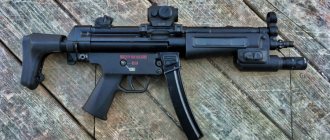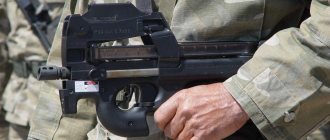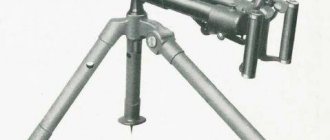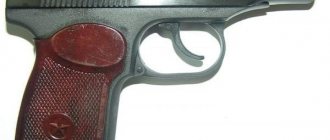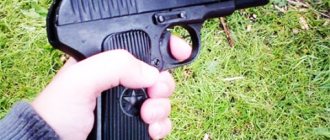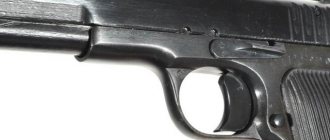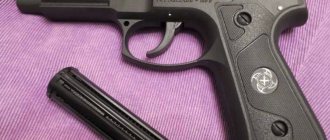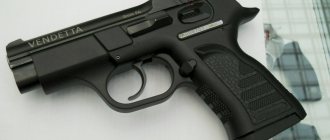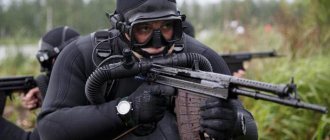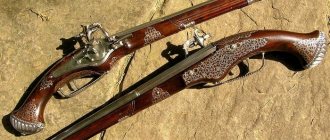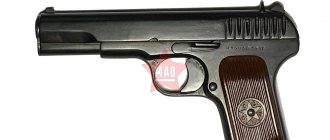Author: liar lawyer
23 April 2014 09:31
Tags: MP-40 PPSh-41 comparison
42106
9
3
I myself am an ardent fan of the Lurkmorye site, and at the same time I am studying weapons from the Second World War. And then I came across a most interesting article, which I present here. The author's spelling and punctuation have been preserved, sorry, but there will be some swearing. PPSh (pepesha, daddy, official 7.62-mm submachine gun G.S. Shpagin model 1941) is a Soviet prodigy, with the help of which the Fritzes, Hanses and other Teutonic trash were cut out. Thousands of them! Since by December '41 the Soviet army had destroyed all the SVT-40s, the Nazis, who had grabbed such toys as trophies, also enthusiastically shot the proletarian Vanek and Abramov. What made this ratchet kosher was the ease of production and all sorts of convenient crap like a perforated casing, which also served as a muzzle brake-compensator, a strong butt, etc. And this despite the wind-up drum magazine, glorified in the annals of WWII soldiers, the cartridges in which were often distorted. History of creation Initially, Soviet generals had more respect for rifles (including self-loading and automatic ones), and did not favor submachine guns, considering them gangster shooters, but in order to keep up with the trend, they still adopted their version for service. It turned out to be the PPD aka the Degtyarev submachine gun - a rather complex weapon, manufactured by milling, which cost almost as much as a whole DP machine gun and therefore was produced in a small series and without much enthusiasm. However, after waving with the Finns in the cold northern forests, the army came to the conclusion: “PP is needed” and gave the gunsmiths a new technical specification: “to do the same thing, but cheaper.” This is how the PPSh appeared. The manufacturing technology for it was much simpler, which made it possible to reduce the cost of production by more than half compared to PPD. The PPSh is almost entirely made from cold stamped parts; all that remains is to screw in two threads and spice up the design with a couple of more complex structural features, so that even a current school student can assemble it if desired (in fact, the Shavers with their “STAN” went the same way). There are known cases when homemade, but fully combat-ready PPSh were riveted by partisans right in the forest, in field workshops, from scrap metal and parts of faulty weapons. The cadavers obtained in this way can be seen in some WWII museums. PPS, however, is even simpler and is more loved by home-made people. Initially, the PPSh was equipped only with a drum magazine for 71 rounds, inherited from the PPD. Such a magazine had to be adjusted to the machine manually. The quality was often so bad that each PPSh came with three magazines that did not fit any other PPSh. What added to Butthurt and the lulz was that the drum magazine was bulky, protruding greatly beyond the dimensions of the weapon, and weighed more than one kilogram empty. The subject with an attached fully loaded drum magazine pulled approximately 5.5 kg. Regarding the warping of cartridges: there is an opinion that this is not least due to the “bottle” shaped cartridges - Thompson and Suomi used cartridges with cylindrical cartridges, and therefore the tendency to distortion in their drum magazines was less (the cartridges fit closer to each other). Subsequently, a sector (school “carob”) magazine with 35 rounds of ammunition was cut down, although less capacious, but devoid of these shortcomings. Also, in a later version, the fire mode switch was removed (a small gimmick in front of the trigger), rightly reasoning that a simple Red Army soldier should not bother with such nonsense as single-shot shooting, but the machine gun would be cheaper. Due to this, as well as other improvements, the machine gun in 1942 came very close in price to the Mosinka and was able to become the second most popular weapon after it. Main advantages and disadvantages Operating instructions Simplicity and low cost of production. Reliability. The highest among competitors (thanks to the 7.62×25 TT cartridge), the initial speed of the bullet is high penetrating ability, long effective range (100-200 meters). High accuracy (in case of single shots) and stability when shooting in bursts (due to the muzzle brake and heavy weight). If the same MP-40 throws up noticeably when firing and does not shoot accurately in bursts, then from the PPSh you can spray the enemy with lead like from a hose. Among the disadvantages, we can note: Tendency to spontaneous shots when falling on a hard surface (a common disease of all SMGs with a blowback shutter) Low stopping effect (again, thanks to a high-speed small-caliber bullet, which simply pierced the Fritz’s carcass and took away most of the muzzle energy). A high rate of fire (see video) is a controversial point: high firepower on the one hand and excessive consumption of ammunition on the other. Due to the enormous rate of fire, he received the nickname “Shpagin’s Ammo Eater.” It is difficult to bring it back to normal in case of icing - the drum store holds a lot of water and ice is produced from it accordingly - they were warmed up over a fire. In the Great Patriotic War, the PPSh was the main submachine gun of the USSR. During the war, more than five million pieces were produced, and from the forty-second year, PPShs were made to order from the Soviet Union in Iran. PPSh-41 vs MP-38/40 The main ideological competitor of the PPSh was the racial German fascist submachine gun Erma MP-38/40, originally sawn as a self-defense weapon for tank crews (under the barrel there is even a special hook/stop, which was supposed to cling to the edge tank hatch or embrasure and shoot back). The fight between MP-38/40 and PPSh is still going on. And this is sad, because the comparison is not entirely correct. It would be more logical to compare the PPSh with the MP-41 “Schmeiser” (Yes, “Schmeiser” because Hugo himself participated in its development. At the same time, calling the MP-38/40 “Schmeiser” is unforgivable amateurism and is worthy of suicide for the apsten). This modification did not have a pistol grip, but it had a comfortable wooden stock with a wooden, integral, awkward butt) The Nazis themselves willingly used captured PPSh, since it could fire 7.63 mm Mauser cartridges (in fact, the 7.62x25 cartridge is nothing more than a Mauser cartridge produced in the Union, of which the Red Army had plenty - however, both cartridges are not the same, at least in terms of gunpowder charge, and therefore could jam at the most inopportune moment). The Germans also redesigned the PPSh for their 9x19 mm cartridge, replacing the barrel and installing a receiver under the magazine from the MP-38/40. This alteration was reversible - it was possible to return the old barrel and shoot with Soviet cartridges. In turn, Soviet soldiers of the MP-38/40 also did not disdain, especially the scouts, who behind the front line, if something happened, it was easier to get cartridges for a German machine gun than for a PPSh. Also, if in the forest behind the trench shots are heard not from the Vaterland MP, but from another submachine gun, then this is quite suspicious, isn’t it? Myths and legends Imperial sappers-stormtroopers. Also, it would be better for the left one not to get captured - no one liked flamethrowers anywhere. PPSh is a copy of the Finnish Suomi assault rifle. In fact, only the magazine was taken from Suomi; the internal design is seriously different. In general, the PPSh was a fairly typical submachine gun of the mid-twentieth century. For example, the appearance of all the machine guns was very similar - just look at the German MP-28, the Italian Beretta M938a, Suomi and the same PPD. There were few PPSh, while the Nazis were universally armed with MP-40s. In fact, the main weapon of the German infantry was the Mauser K98k carbine - a shortened (although not so cut off - the Germans until 1945 called a carbine not a short rifle, but a converted version for cavalry) version of the original Mauser Gew rifle. 98, and the MP-40 was only owned by squad commanders (this was at the beginning of the Second World War), which approximately corresponded to the distribution of PPSh in the Soviet army, although we had more submachine guns per infantry company than the non-Maks. The MP-40 was used en masse only by tankers, paratroopers and rear units. To be fair, the German army was better equipped with machine guns (wunderwaffle w: MG-34), which had a stronger effect than the presence of the MP-40. The PPSh is heavy and uncomfortable. Everything is relative. A PPSh with a lightweight box magazine is an extremely convenient thing. The PPSh with a box magazine weighs 4.3 kg, and with a drum magazine - 5.45, while the Tommy Gun weighs 4.8 kg, and the loaded MP-40 - 4.7 kg. Only the little-known descendant PPSh-2, the Pindos M3 (aka “Grizgan”) and the English STEN weighed noticeably less than the PPSh. The last two were not designed out of a good life, in austerity mode, so that, in fact, they were second-class machine guns, especially STEN - its defectiveness outweighed even its cheapness (however, with its help, some managed to bend and even loved it), and PPSh- 2 was generally cut down by Semenych so quickly that he didn’t even have time to pass the tests, although he could compete in compactness and small dimensions even with the knot. The M3 was a fairly high-quality weapon - Vietnamese partisans and Philippine special forces guarantee this! (The latter still do.) But running a forced march with a drum magazine with a PPSh behind your back is a complete nightmare. The soldiers had to use any methods to get the box magazine. PPSh - the best machine gun of the Second World War. Oddly enough, I missed it again. The w:PPS-43 (aka Sudaev submachine gun) was recognized as the best, which, despite all its outward unpretentiousness, was distinguished by such simplicity, reliability and unpretentiousness that the Finns, holding the subject in their hands, abandoned their racial “Suomi” and began to rivet a remake of the PPS for their own cartridge. Nevertheless, the harsh Siberian men deliberately preferred the PPSh for its pleasant weight in harsh hands, the wooden butt (to which the fingers did not freeze), and also the ability to take and fuck the fascist reptile with this butt. Standard use Unlike the Germans, who evenly distributed machine guns among the infantry, in the USSR, in addition to ordinary infantry companies (armed mainly with rifles, although they also had PPSh), there were special companies of machine gunners, who were usually kept in reserve and used to reinforce the most dangerous areas. What’s interesting is that this practice dates back to the First World War, with those interested in gossiping about Fedorov’s assault rifle and the companies armed with them. PPSh were also armed with tank landing forces, and since 1943, with guards engineer-assault units (such tough guys in steel cuirasses) for storming fortifications and urban battles. Non-standard use Towards the end of the war, Soviet designers tried to use PPSh when attacking enemy infantry columns. For this purpose, a platform was designed on which 88 PPSh assault rifles were mounted (11 rows of 8 barrels each). In the combat position, the battery was rigidly attached to the bomb bay of the Tu-2, a la gunship. During the attack, the pilot opened the bomb bay doors and, using a special sight, fired heavily at the enemy. It fired poorly and did not last long, and had to be loaded manually at the airfield. Therefore, cluster bombs turned out to be more effective. Post-war In Iraq with tuning, tuning is done using plastic ties. In the USSR, the PPSh was produced and was in service until 51, after which it was replaced by the Kalashnikov assault rifle. After that, PPSh reserves were actively supplied to Eastern Europe, Korea, Vietnam and Africa to the friendly communist revolutionaries and the cooked nigrams. Also, PPSh was mass-produced in Korea and China until the 80s, so it was seen in almost all local wars in Asia and Africa. In Vietnam, they produced PPSh with a modified body kit, without wood, and with a shortened casing. Currently, PPSh is produced in small batches in Iran, as well as handicraft in other Arab countries. Recently, PPSh was seen in Iraq, and in the hands of racial Pindos. The question of whether they actually use it or are just posing for the camera is a matter of fierce controversy. At the moment, several million PPSh lie in grease in military warehouses, awaiting a new war and reservists who will not have enough AKash. However, many copies are already being cut and sold legally as “models similar to PPSh-41.” Since August 2013, the “VPO-135 hunting carbine” has appeared in gun stores in this country. The converted magazine (a limiter is welded in) holds only 10 rounds and it won’t be possible to fire bursts from the belly - forensic requirements for civilian weapons, you understand - but in all other respects it’s the same PPSh. In folklore, the image of a PPSh with a drum magazine symbolizes victory and a Soviet soldier as clearly as the MP-40 clearly symbolizes a fascist soldier. It is present in many monuments both in this country and in Europe. He is depicted on memorial signs and medals. He can be seen in a huge number of films and games about the Great Patriotic War, as well as newsreels. In Soviet times, plastic all-stamped PPShs (with a removable magazine!) were produced for young builders of communism, with which they played war games a little less than all today's anonymous people. In the Western mass consciousness, the PPSh was a symbol of the Red Menace both before the advent of the AK and then along with it. It is the PPSh that will be armed by countless crowds of Russian Ivans in earflaps and felt boots, who will inevitably invade defenseless America. Also, PPSh is loved by collectors for its severity, brutality and symbolism. I bought a PPSh - kill slowly. Anonymous Life is good when there is PCA. aka Life is beautiful, the soul sings, when you slowly empty the PPSh disk into your PPS outfit. aka And the road is long, foggy, And the forests are swarming with robbers, And I bought an Automatic PPSh system from a homeless man at the station. Singer with his mouth Trofim (now Sergei Trofimov)
Schmeiser has nothing to do with it
The Shpagin submachine gun (PPSh) and MP 38/40, created by German weapons designer Heinrich Vollmer , are the most recognizable examples of Soviet and German personal weapons. The question of which submachine gun performed better is still the subject of fierce debate to this day.
There are two myths about the MP 38/40 in the public consciousness. The first connects its appearance with the name of the designer Hugo Schmeisser , which is a misconception: the famous gunsmith has nothing to do with the creation of the MP 38/40.
The second myth took hold thanks to films about the war, in which the Nazis were all armed with submachine guns.
In fact, the main weapon of the German infantry was the Mauser 98K carbine. The MP 38/40 was originally designed for tank crews, airborne units, reconnaissance units, and other special forces.
German soldiers with MP 38/40. Photo: Commons.wikimedia.org/German Federal Archives
Design. Principle of operation
The MP40 striker-type trigger can only be fired in bursts. There are no safety devices; instead, there are two slots for the bolt handle on the left side of the bolt box. The first groove is located in the breech of the casing and is intended for preparation for firing, the second is located near the chamber and is necessary for completely locking the barrel bore in the stowed position.
MP 40 submachine gun
The weapon's sights are a rack-mount sight with two viewfinders. The first sight is permanent, designed for a distance of 100 m, the second is folding for a distance of 200 m.
MP-40 submachine gun disassembled
The principle of recoil of a free bolt with a stationary barrel is the basis for the operation of the MP38 and MP40 PP automatics. This “roll-out shot” principle was developed by Hugo Schmeisser. According to this approach, at the moment the barrel is locked with a massive bolt, the striker striker and the cartridge primer come into contact. The submachine gun has a relatively low rate of fire - 600 per minute. The reason for this is a weak return spring, the heavy weight of moving parts and the presence of a pneumatic damper. But this drawback can also be considered a plus, because due to the relatively low rate of fire, accuracy improves and it becomes possible to fire single shots.
At the bottom of the weapon barrel there is a kind of “hook” for the convenience of firing from various shelters, the sides of armored vehicles, etc.
MP 40 handle pads
The main parts of the MP40 are as follows:
- gate;
- barrel and receiver;
- trigger box with fire control handle and shoulder rest;
- trigger mechanism;
- return mainspring;
- shop.
Shutter design
The weapon's bolt has a cylindrical shape. In front of it there is a cup, which at the moment of the shot houses the rear part of the cartridge case. At the bottom of the bolt there are grooves for the passage of the jaws of a removable magazine and a weapon rammer, which pushes a new cartridge out of the magazine and into the chamber. There is also a slot for a reflector of spent cartridge cases.
Shutter and needle (striker) MP-40
The rear part of the bolt has a fixed cocking handle. In addition to the main function, it also served as a fuse - with its help it was possible to fix the bolt both in the front position (using the lateral displacement of the chip placed on it, which engages with the cutout for the cocking handle on the receiver) and in the rear ( the handle is inserted into the side extension of the rear part of the slot).
MP40 grip and stock
As for the early versions of MP38/40 and MP 40, they did not have the feature on the bolt handle described above. There was only a simple hook that was fixed in only one position - back. Such a simple design was very unreliable - the weapon could fire spontaneously if there was a fairly strong impact along the axis of the weapon or if it was shaken (for example, when jumping from a vehicle or landing from the air).
This is interesting: the Germans tried to solve the lack of a sliding feature by making special safety straps that were put on the barrel and fixed the bolt in the forward position.
Later, starting in August 1942, this problem was solved by issuing a decree to convert all MP38/40 with hook handles into handles with a chip by cutting out a groove for the safety in the front of the receiver.
The weapon's firing pin had a special feature - it was a separate part located in the internal channel of the bolt. Its base also served as a stop for the return mainspring.
MP-40 recoil spring and telescopic casing
The recoil spring, together with the base of the firing pin and the surrounding telescopic casing of tubes, formed a separate assembly unit that did not require maintenance under normal operation. These tubes filled with air served as a simple fire retardant. This approach simplified the design of the trigger mechanism and made it possible to abandon the single-fire function. In addition to the function of a retarder, the steel tubes also reliably protected the spring from mechanical influences.
Telescope MP 40
Some later MP40 releases lacked the pneumatic retarder and telescopic shroud. This approach had a direct proportional impact on the reliability of the weapon, because the spring was strengthened, and the protection against contamination was leveled.
Bolt box of a submachine gun
This part is made of rolled cheap carbon steel. On top there was a base for a sight, in which a bar with an aiming post was placed. The stand had a slot for a stationary sight at 100 m and a folding bar for shooting at 200 m. Quite often, such a sight was replaced with a sector sight, divided in increments of 50 meters at a distance of up to 300 meters.
Shutter MP-40
A magazine receiver is placed in front of the bolt box. This part is made of sheet metal or aluminum and has a reflector and magazine release inside. Above the magazine receiver on the right side of the bolt box there is a cartridge ejector window.
Weapon magazine and ammunition
The PP magazine has a box-shaped, straight shape. The cartridges in it are arranged in a checkerboard pattern. Ammunition was delivered by a feeder with a steel spring made by extrusion. This significantly reduced the cost of production. When loading ammunition into the chamber, the front end of the cartridge case is fixed into its ledge.
MP40 magazine
The weapon uses a 9x19 mm Parabellum cartridge. At the initial stage, cartridges were of 2 types: with a round-topped conical bullet and a flat-topped conical bullet. Further, during the Second World War, the variety of bullets expanded significantly - both jacketed bullets with a steel (P.08 mE) and lead core (P.08 SE) and non-jacketed surrogate bullets made of metal-ceramic mass were used. As for the latter, it was of the greatest interest, as it had sufficient power, accuracy and a flat flight path. The cartridge used cylindrical shells with a non-protruding flange. They were made from steel, aluminum, brass and bimetal.
Possible additions to weapons
As for the various additional “devices” for this weapon, they are a silencer, a magazine filler and a winter trigger.
Silencers
At the official level, mufflers were not used for the MP38/40 models, but in reality there were even several models of them. If you believe official documents from 1944, then in total about 1000 - 1500 units of various variations of mufflers were manufactured. All of them were made. The model range of mufflers from Hub L41 to Hub L50 is known. For example, in 1942, two types of mufflers were developed - Hub L41 and Hub L42. The first was created by the Brandenburg company Arado, the second by the Schneider-Opel community. Hub L41 weighed 700 g, had a length of 295 mm and a diameter of 43 mm. The Hub L42 model had a length of 350 mm, a diameter of 45 mm and weighed 600 g. Each of the suppressors required a special cartridge with a lighter charge and a somewhat heavier bullet - a certain close-range cartridge Nahpatrone 08.
MP-40 submachine gun with silencer
Winter trigger
In German it sounds like Winterabzug. This device made it possible to fire a weapon without taking off the mittens. I met very rarely. Externally, it was a thin-sheet metal box with a removable sidewall and a trigger. It was located below the “factory” trigger guard.
Winter trigger for MP-40
Store filler
This “thing” made filling the magazine with cartridges much easier. The Magazinfüller is a special device in a metal case that is attached to the neck of the magazine. In its upper part there was a special lever, with the help of which the magazine was filled with cartridges.
MP 40 assault rifle magazine filler
Blitzkrieg weapon
Despite the fact that by the beginning of the Great Patriotic War, the Wehrmacht had less than 300,000 MP 38/40 in service, they were used extremely effectively.
The submachine gun was compact, lightweight, and had a magazine with a capacity of 32 rounds that was easy to load and replace.
The 9x19 mm Parabellum cartridge and rate of fire of about 600 rounds per minute ensured the greatest effectiveness in combat conditions at distances of no more than 150-200 meters.
During the period when the Nazis were actively attacking, the MP 38/40 proved itself to be excellent.
Question answer
Shpagin submachine gun. Infographics
Assembling and disassembling weapons
In order to disassemble the weapon, it is necessary to carry out the following manipulations:
- First of all, we disconnect the magazine of the submachine gun.
- Pull down the locking bolt by the button. Next, rotate it a quarter turn to the left or right.
- We take the weapon by the neck of the magazine and the pistol grip and rotate them relative to each other counterclockwise. The trigger must be pressed at this moment. Next, we separate the receiver along with the neck and barrel by pulling it forward.
- We remove the bolt from the receiver.
A German soldier cleans an MP-40.
We assemble the weapon in the reverse order.
Urgent task
The Shpagin submachine gun was created in 1940 under conditions of acute time shortage. The People's Commissariat of Armaments demanded that a model be developed taking into account the best achievements of design ideas, but at the same time technologically advanced and adapted for mass production, including at non-specialized enterprises.
Georgy Semenovich Shpagin succeeded in the impossible: the first sample of the PPSh was manufactured in August 1940, and already in December of the same year the submachine gun was adopted by the Red Army.
Marines in the battles near Tuapse, 1942. Photo: RIA Novosti / Alexey Mezhuev
Advantages and disadvantages
Shpagin created his PPSh chambered for the 7.62x25 mm TT cartridge, which is significantly superior to the 9x19 mm Parabellum in terms of direct shot range and penetration power.
The rate of fire of the PPSh reaches 1200 rounds per minute. On the one hand, such a rate of fire led to rapid overheating of the weapon and consumption of ammunition. On the other hand, in close combat conditions, a Soviet soldier, due to hurricane fire, had a greater chance of destroying the enemy and saving his own life.
The PPSh was more stable in field conditions than the MP 38/40, which allowed experienced shooters to conduct targeted fire with single shots.
At the same time, the 71-round disc magazine was inferior to German weapons in terms of loading speed and reliability. At first, the PPSh did not have the ability to use discs from other copies in the submachine gun.
Article on the topic
Secrets of the “three-line”. Who invented the most famous Russian rifle?
Over time, Soviet gunsmiths solved this problem, and then PPSh began to be produced with sector magazines for 35 rounds.
The PPSh was superior to the MP 38/40 not only in rate of fire, but also in its effective firing range, reaching 300 meters.
The Soviet submachine gun was more bulky and heavy, but in hand-to-hand combat this became an advantage: the PPSh turned into a real “club of the people’s war” that successfully fell on the heads of the Nazis.
Faithful PPSh. The history of the most recognizable weapons of the Great Patriotic War Read more
Exemplary Makhnovshchina against the ugly Ordnung. MP-40 and PPSh-41
Since we are talking about such weapons as submachine guns, it is worth understanding for what purpose they were introduced into the troops in the first place. Let me start with the fact that starting from the 18th century, infantry suffered the main losses from artillery fire. The second most effective damaging factor was hand-to-hand combat. And only in third place were losses from infantry small arms fire. The entire history of the development of military affairs demonstrates the steady desire of the warring parties to avoid hand-to-hand combat and hit the enemy at the longest possible distance. As soon as production capabilities began to allow this, long-range rifles immediately began to be introduced en masse. For a short period of time, they even matched the firing range of field artillery. What did this lead to? And to the fact that it became impossible to concentrate artillery the way it was done in the Battle of Borodino. 640 guns on a 5 km front was no longer an affordable option at the end of the 19th century. The shooters will quickly leave the guns without crews. As a result, with an increase in the rate of fire, not only the infantry, but also the artillery dispersed their battle formations. Now the division, stretched out along a 5 km front, could hope to be supported by ten times fewer artillery barrels than it was in the Battle of Borodino. And if we consider that the infantry is now advancing not in dense columns, but in sparse chains? In general, what is important for us is that the artillery firing distances against attacking infantry remained the same: 200 - 2000 m, but the density of artillery fire decreased. We had to supplement it with small arms fire.
Immediately the question is: How will an infantryman hit the target at such a distance? Answer: he cannot fire accurately at the enemy at such distances. Literate people have always understood this. The fire should be not so much accurate (which in principle is not achievable) but dense. Any rifle unit should be considered as the barrel of a gun firing at the enemy with buckshot. The artilleryman does not at all strive for each striking element to fly to the target, he simply creates a barrier of buckshot and fragments. In the same way, an infantry commander, with the fire of his unit, creates a barrier from other destructive elements - bullets. And the thicker this barrier, the better for the shooters. True, no one refused to conduct aimed fire. It was just conducted at closer distances: starting from 400 meters.
The desire to make the barrier of bullets as dense as possible led to the creation of rapid-fire systems - machine guns. The task of the machine gunners was to create a dense barrier from the fired bullets. But no solution to the pressing problem is final. Although machine guns proved to be an effective means of destroying enemy personnel, their fire was clearly not enough. The attacking enemy still passed through their barrage and found themselves at close combat range. As soon as this happened, the losses suffered by the attacking infantry fell sharply. Why? But because artillery was immediately excluded from the battle at this distance, and the existing machine guns could no longer fire along the entire front. And if up to a distance of 200 m, the enemy approached by dashing and crawling, then here he was already reducing the battle distance with a friendly and swift jerk.
There were two ways to stop such an attack.
The first method is a counterattack and bayonet fighting. But for this you need to have either an approximate equality of strength, or sharply superior to the enemy in moral and volitional qualities. It is not always achievable, which means the result is not predictable in advance.
The second way is to meet with dense fire at close range and inflict unacceptable losses on the enemy. After this, hand-to-hand combat, if it occurs, will be not so much destruction as finishing off the enemy.
The second option was preferable, but it required increasing the saturation of rifle units with automatic weapons.
The saturation of the infantry with automatic weapons proceeded in several stages. First, they increased the number of heavy machine guns. Did not help. And the saturation limit was immediately revealed - no more than one machine gun per infantry platoon. We needed something lighter and more maneuverable.
Then, light machine guns were used. It didn't help either. True, the saturation limit turned out to be better - one machine gun per rifle squad.
The conclusion was drawn: in a rifle unit, all fighters should have the ability to conduct automatic fire. Therefore, starting from the end of the Russo-Japanese War, gunsmiths became concerned with the creation of automatic rifles.
The basic requirements for the destructive properties of such weapons were clear then and have not changed to this day. This is the ability to conduct barrage fire both with single shots and in bursts at all combat distances. And starting from a distance of 400m, the infantryman must be able not only to conduct barrage, but also targeted fire in order to independently suppress enemy fire. At the same time, the weapon must be superior to a machine gun in terms of maneuverability.
Why it was not possible to create such a weapon right away is clear to everyone. Creating it on the basis of the then existing rifle cartridges was a difficult task. As a result, in order to solve it, we had to reduce the power of the ammunition. They did not immediately decide to create another type of cartridge. Therefore, they tried to create an automatic carbine based on a pistol cartridge. They created it, but what came out could not satisfy the infantry. The infantry categorically did not want to fight only at close range. Therefore, a new type of rifle, called a submachine gun, did not become a mass infantry weapon. The infantry chose to wait patiently until the designers finally created at least something acceptable. We had to wait a long time. Almost forty years. In the meantime, we made do with what was created already in the 19th century - repeating rifles.
It seemed that the submachine gun could be forgotten, leaving it as a “weapon of gangsters and policemen.” But it's not that simple.
The wars of the early 20th century showed that not all fighters needed long-range weapons. Why does an artilleryman need a rifle that can shoot several miles, if his main weapon in battle is a cannon? He will take up his rifle when the enemy comes too close. The same can be said about signalmen, orderlies, ammunition carriers, and sappers. The scout also does not need to shoot into the distance. What about the commanders? Their main task is organization and management. If he starts firing himself, then who will assess the situation on the battlefield? And there is no need for the transporters to fight at long distances. Everyone I have listed is forced into a firefight at close range. This means they need self-defense weapons. Lightweight, compact and quick-firing. At first this weapon was a pistol. Practice has shown that this is not enough. Why? And if only because the concepts of “coming within pistol shot” and “coming within grenade throw distance” mean the same distance. At the same time, the grenade can be thrown with precision and from a longer distance. This means that the pistol needs to be replaced with something longer-range and faster-firing. This “something” must confidently hit the enemy from the distance of a bayonet attack (200m) to point-blank combat. The submachine gun was quite suitable for such requirements. The designers only had to create an acceptable sample. Over time, they created it. But the quality of the weapons created depends not only on the talent of the designer. The sanity of the customer also greatly influences the result obtained. The history of the creation of the MP-40 and PPSh-41 clearly demonstrates this.
To begin with, take and compare the mentality of a German officer, a tsarist officer, the army commander of Father Makhno and the commander of the Red Army.
For example, we take an ordinary sprung cart carrying a heavy machine gun, ammunition for it, and the machine gun crew itself. The German officer knows that upon arriving at the battlefield, he needs to remove the machine gun and drive the cart to the rear. And then fight, as is customary throughout the civilized world.
A tsarist officer will appreciate this device in the same way as a German officer: a good vehicle that allows you to quickly transfer an unassembled machine gun to the battlefield along with the crew. That is, he will also look at it as a vehicle, not a combat vehicle.
The coincidence of views should not be surprising. Europe, since the time of Peter the Great, has been an example in everything, primarily for the ruling class. As a result, imitation led to a complete change in mentality mainly among the nobles and the intelligentsia who joined them.
The Soviet officer is a product of a different influence. No matter how hard communist propaganda tried to create a European out of him, it failed. And even a return to the glorious traditions of the Russian Imperial Army did not make him an analogue of a tsarist officer. At heart he was and remained either a Makhnovist or close to Makhnovshchina. What does this mean? And the fact that he never got rid of his folk roots and retained the originality that all Russophobes stubbornly fought against. Well, a French wig doesn’t suit a Russian face! And among the tsarist officers, he was closer to the eccentric Suvorov, Ermolov, ironic towards foreignness, or the chauvinist Skobelev. They, too, were atypical people for that time. They would obviously be more comfortable in the Red Army.
Understanding this subtlety, one can understand their specific approach to innovations in military affairs. Let's return again to our example with a sprung cart:
The logic of the Makhnovist officer is this: Isn’t it shaking? Doesn't the aim throw you off? So why the hell dismount and waste precious seconds? Let's go before these bitches come to their senses! Return fire? Are you guys completely stupid? They will lie with their faces on the ground and fill their pants with shit!
The logic of the commander of the Red Army somewhere near Makhnovskaya: Moving? Shooting? That means a tank! And the fact that oats consume instead of gasoline is nonsense in comparison with the World Revolution!
This difference in approach to their craft has remained to this day. This is well illustrated by the history of the most famous weapon of the Second World War, which became a symbol of the warring parties.
Most readers cannot separate the German soldier from the MP-40 submachine gun, erroneously called Schmeisser.
In our minds, a Soviet soldier is strongly associated with a warrior holding a PPSh-41 in his hands.
This is where a completely different approach to weapon design emerged. For example, a submachine gun. Neither we nor the Germans intended to transform the submachine gun into the main weapon of their infantry. Everyone correctly assessed the true combat value of this weapon: it is a self-defense weapon and not a main military weapon. It was planned to be created for the needs of an exclusively limited category of military personnel.
What are these categories? First of all, these are those commanders for whom the ability to fight as part of their unit with personal weapons is a dire necessity. This is usually from the squad commander to the battalion commander. To do this, they should have been armed with something more powerful than a pistol, but more compact than an infantryman’s rifle.
Tankers should also have something similar. And it won’t hurt paratroopers and scouts. And various kinds of rear and auxiliary units, whose direct participation in battle is rare. After all, they also need not so much a full-fledged combat weapon as a powerful self-defense weapon. But this is in Germany. And in the USSR?
“On October 27, 1925, the Red Army Armament Commission stipulated the desirability of arming junior and middle command personnel with this type of weapon.”
And at the same time those categories that were mentioned above. That is, there were differences of opinion on the scope of application. The disagreement went elsewhere.
The German soldiers clearly and clearly stated: “We want in the end to get what we ordered.”
The designers understood them perfectly and delivered what the customer wanted. And they started with the choice of ammunition. First of all, they made sure that the selected ammunition was intended for those pistols that were in service. And what characteristic, among others, was considered important for pistol ammunition? Stopping (concussive) effect. The German pistols “Parabellum” and “Walter” were equipped with the 9x19 mm Parabellum cartridge.
And what did they get? This:
Pistol - MP-40 machine gun
“The weapon is compact and powerful and easy to use. High quality workmanship and durable design go without saying. Germans after all! The MP-40 had a moderate rate of fire, good weapon control, high accuracy and accuracy of fire. All hits when firing from an MP-40 mounted in a machine are placed in a circle with a diameter of 7 centimeters at a distance of 50 m, 10 cm at 100 m, 25 at a distance of 200 m, and there is also a relatively high stopping effect of a 9-mm bullet at ranges up to 200 m.
In addition, at the end of the MP-40 barrel there is a thread covered with a screw-on sleeve, which makes it possible to use silencers and fire over-caliber ammunition.”
That is, they received weapons that were quite good by the standards of that time. The German designers met the parameters they set. Much the same thing happened in other European countries. That is, the logic of both the military and the gunsmiths coincided completely.
How did it behave in battle? Yes, it behaved well. He also had disadvantages:
— The inconvenience of the metal butt and the not entirely successful connection system (the hinge of the butt, with frequent tilting, quickly wore out and began to wobble, which affected the shooting accuracy)
— Not the best ergonomics: firstly, it is excessive (by modern standards) massiveness of the weapon, and secondly, the cocking handle located on the left, when carrying the weapon in the “chest” position, sticks into the owner’s chest, causing him discomfort. In addition, due to the long, strongly protruding magazine, it is difficult to fire from shelters (primarily trenches), since this significantly increases the aiming line when shooting prone or from behind cover, so that in order to conduct aimed fire you have to stick your head out strongly, exposing yourself under enemy return fire
— Absence of a barrel casing (which makes it impossible to hold the weapon by the barrel without gloves during prolonged shooting).
And here, heresy was woven into this triumph of reason and culture. The Soviet commanders initially needed the same thing as the Germans, but: “We want in the end to get what we ordered and something else in addition.”
What were they dreaming about? And they wanted weapons of limited use to be suitable for the battle waged by infantry. The weapons designers failed to explain to them that this is the wrong approach, that only idiots think this way. Since the customer is always right, cursing the gray-footedness of the ignorant, they began to look for a way out. And who is looking... In short, 9x19 Parabellum and 7.62x39 Nagan
had to be rejected.
7.62x25
was taken as a basis . Why he? The Mauser-Tokarev cartridge 7.62x25 mm has obviously better ballistics.
What about the stopping effect? Our “Makhnovists” reasoned simply: The stopping effect is important when fighting at point-blank range and in a single shot. A wounded person at long range will bleed out faster than he can reach you. And when fighting at a very close distance, a point-blank burst of any caliber is like buckshot for a wild boar.
But still, why did they need it? Everything is very simple. Due to their gray-legged nature, the Kraskom believed that units that had been exhausted on the battlefield would not always be able to receive marching reinforcements on time or be withdrawn for reorganization. In this case, commanders will have to replenish rifle units with personnel from special units. And since they will have in their hands the weapons that are required by the state, then it is with these weapons that they will have to carry out combat missions characteristic of the infantry. This means we are improving ballistics as much as possible.
But it was the Red commanders who decided so. But besides them, the Red directors also turned out to be real Makhnovists:
In addition to its high combat qualities, the choice of this cartridge was supported by the fact that the production of 7.62 mm barrels for both pistols and submachine guns could be carried out using the same technological equipment, and the barrel bore was unified with the Mosin rifle made it possible to use existing equipment and even defective blanks of rifle “three-line” barrels. In addition, the bottle-shaped cartridge case increased the reliability of delivery from the magazine.
What happened in the end? As a result, the Degtyarev submachine gun of the 1940 model was released. Not right away. There were also earlier samples: PPD-34, PPD-34/38, PPD-39...
Here's what they looked like:
Pistol - machine guns PPD - 34 (top) and PPD - 40
My opinion: It is the PPD-40 that should be compared with the MP-40. Moreover, they were created in peacetime and at the same time. At first glance, the palm should be given to the MP-40. In terms of reliability, it is equal to PPD, but is easier to manufacture and cheaper. In addition, it is clearly more convenient for a fighter. But this is at first glance. You can list the many design flaws inherent in the PPD-40 that the MP-40 did not have and based on this conclude that it is worse. All this will be true, but let’s not rush to conclusions. Wars test the true value of weapons. Both of these machines have seen many wars. The most recent use of the PPD-40 in combined arms combat was May 2014 in the Donbass. And the MP-40 was finally withdrawn from service only in the 80s. It is necessary to compare not only tabular characteristics and design solutions. It is also necessary to compare the capabilities of weapons that were fully demonstrated during the war. I will do this using the example of comparing the MP-40 and PPSh-41. Why is that. Yes, because the PPD did not suit the army. It was a painfully expensive toy.
When trying to increase the production of PPD, it became clear that it was quite complex structurally and technologically, and very expensive to produce, which prevented the establishment of its mass production.
“By order of the Art Directorate dated February 10, 1939, the PPD was removed from the 1939 production program, orders to factories for its production were canceled, and the copies available in the Red Army were concentrated in warehouses for better preservation in the event of a military conflict, and the pistols in storage were machine guns were ordered to be “provided with an appropriate amount of ammunition” and “stored in order.” A certain amount of PPD was used to arm border and convoy troops; sometimes there are even reports that a small amount of them were produced for these purposes.”
As you can see, the MP-40 beats the PPD in many respects. True, at this moment there is no MP-40 yet. There are his few prototypes MP-36 and MP-38. But they also give PPD a head start.
At this time, we decided not to rush. Give gunsmiths time to create high-quality and cheap weapons. But then the Finnish War intervened.
The use of submachine guns in the war with the Finns in 1940 is poorly covered. They talked more about the Finnish Suomi assault rifle. However, the Finns did not draw revolutionary conclusions from this, like the rest of the world. But our dear Makhnovists knew how to think outside the box. The fire of rare Finnish machine guns made a strong impression on them. Here's the thing. Anyone who has ever come under machine gun fire remembers very well all the fear and feeling of helplessness that he experienced. This is never forgotten. You remember it for the rest of your life: getting caught in a queue is terrible!
Suomi-konepistooli M/31 (KP/-31, Suomi KP)
“The Finns were armed in relatively small quantities (no more than a few percent of the total number of small arms) of the successful Suomi submachine gun of the A. Lahti system, which, however, they used very skillfully, which, in the conditions of heavy fighting on the Mannerheim Line, made a great impression on rank and file and command staff of the Red Army. Demands began to come from the army units participating in the hostilities to equip “at least one squad per company” with submachine guns.
The actual widespread use and effectiveness of the Finns’ use of submachine guns in that war are still controversial topics among military historians and publicists.
Please note: people who have been in war are demanding that “at least one squad” armed with machine guns be included in the rifle company. And they understand perfectly well that this will complicate the supply of ammunition to the troops. But they demand it nonetheless. Somewhat later, during another war, their demands will increase. They will begin to demand an additional platoon of machine gunners in each battalion and a company of machine gunners in each regiment. And why? But because fear has big eyes. The Finns were simply frightening with their liquid machine gun fire. But the Germans were no longer scary. The crew of the MG-34 machine gun, quickly moving across the battlefield, easily created the impression of the presence on the battlefield of a significant number of people armed with automatic weapons. Hence the stories about hordes of machine gunners, of which there were actually very few. You can laugh at our veterans, or you can try to understand their logic. No matter how small the actual result from the use of PP, the fact that it is capable of having a strong psychological impact on personnel was worth taking into account. Therefore, the saturation of our own PP troops should have been increased, if only in order to encourage our own troops. That is why the Makhnovists demanded machine guns not only for certain categories of military personnel, but also for their mass introduction into the arsenal of rifle units. Thanks to this, the interrupted production of PPD was resumed. They are needed more than previously imagined. But here’s the problem: to equip the army with machine guns, even according to previous ideas, it took about ten years of time and a lot of money. There was no point in waiting so long; there was already a war going on in Europe, and no one doubted that we would soon have to fight. Gunsmiths had to look for ways to simplify the production of submachine guns. The PPSh-41 assault rifle turned out to be an acceptable solution to the problem. What was he good at? First of all, by maintaining the combat characteristics achieved by the PPD, the PPSh was initially designed for the possibility of production at any industrial enterprise with low-power pressing equipment, which turned out to be very useful during the Great Patriotic War.
Submachine gun PPSh-41
Here we come to the subject of comparison. What happened in the end? At first glance, everything is bad. Or rather, it was bad, but it got worse. When describing the shortcomings that the PPSh had, one gets the impression that it would have been better not to have produced it. Judge for yourself: the rate of fire is excessive. This is a real ammo eater. The disk magazine sounds like it's capacious, but in reality, given the existing rate of fire, it quickly gets emptied. In addition, it is impossible to equip it in combat conditions. In general, drum magazines in combat conditions proved to be unreliable, excessively heavy and expensive to manufacture, and also required manual individual adjustment for each specific submachine gun. And here's another:
“A fixed firing pin causes delays in firing. when the bolt cup becomes contaminated with soot or dust gets on the thickened lubricant: according to the recollections of veterans of the Great Patriotic War, when traveling in open cars or armored vehicles on dirty roads, the PPSh was almost always hidden under a raincoat.”
“The fiber shock absorber, which softens the impact of the bolt on the receiver in the rear position, had low survivability; after the shock absorber wore out, the bolt broke the rear part of the receiver.”
“Due to the presence of a muzzle brake-compensator, a neighboring shooter who finds himself at a distance of up to 2-3 m to the side of the muzzle can suffer barotrauma or a ruptured eardrum.”
You can shit it well if you want. The stated target range of 500 m caused particular ridicule among critics.
In general, one can find many reasons to accuse Danila the master of stupidity and clubbing. And it’s even more possible to laugh at our dear “Makhnovists” who attributed fantastic properties to the PP.
But you shouldn't do this. In 1941, no one had the opportunity to appreciate the PPSh. The main reason is that there were really few of them yet. On paper it should be enough, but in reality it’s a mere pittance. In addition, single application and mass application are completely different things. And so, by the end of 1941, the Red Army had the opportunity to use PP en masse. And what happened? But it turned out that the Makhnovists were right from the beginning. First of all, in choosing the type of ammunition. The initial bullet speed is 500m/s. This immediately gives us a good flatness of the trajectory. Lethal force is maintained at a distance of 800 m. What does this give us? At a distance of 200m we can fire to kill in bursts. But this was possible from most PPs of that time. But for PPSh-41 this is not the limit of possibilities. In addition, he could conduct targeted fire with single shots at a distance of 300m. That's better. But this is not the limit. When conducting concentrated fire by a squad of machine gunners, it became possible to conduct actual fire at a distance of 400-500 m! I repeat, this is fire from a squad and not from a single shooter. So what happens? But it turns out that the PPSh-41 and PPD-40 are closer in their combat capabilities to assault rifles! So it was not foolish to indicate such an aiming range! And it is possible to use PP as an infantry weapon!
What about the Germans? And until the end of 1941, the Germans did not have the opportunity to truly appreciate their cool device. In accordance with their pre-war ideas, they armed with PP certain categories of military personnel from the construction battalion to the landing force, and in the infantry only commanders. There was no need for the massive use of PP on the battlefield. Everything was going wonderfully anyway. Thunder struck in December 1941. The defeat of German troops began near Tikhvin, Rostov and Moscow. And the defeat was such that the German generals sang “wonderful” songs. Some sang about the need to retreat before the onset of warm weather, others even that it would be nice to start peace negotiations with the USSR. True, after the Fuhrer’s order “Not a step back!”
and the widespread introduction of penal battalions and barrier detachments into combat practice, the “singers” shut up.
We had to hold back the onslaught of the Red Army with all our might. Everything possible was used. In the Wehrmacht, the mass implementation of the Makhnovist Heresy began.
That is, everyone who was at hand and with what they had in their hands was thrown into battle.
So in the infantry combat formations there were many people armed with MP-40 and other similar systems. And what was the effect of its more widespread use? Not the one in the Red Army. Ugly Ordnung: “What you ordered is what you got!”
And they received good weapons, but only for close combat, unable to significantly influence the outcome of a combined arms battle. That is, for infantry the MP-40 is practically useless.
The saboteurs were also dissatisfied. To use a silencer, you need ammunition with an initial bullet speed of no more than 330-340 meters per second, which further reduces the range.
So 150 meters is the effective firing range, this is the maximum that could be squeezed out of a weapon for such ammunition.
One way or another, the war dictated its own rules. The Germans, having learned a cruel lesson in the winter of 1941, did everything they could to improve the situation. An example of such efforts was the birth of the MP-41
MP-41 submachine gun
What changed? To improve shooting accuracy, the famous German gunsmith-wrecker Hugo Schmeisser
, used a wooden stock and butt. This really improved shooting accuracy. Not a stranger to imitation, Schmeisser provided for the MP-41 the ability to conduct single fire. This reduced ammunition consumption, but did not increase the range of aimed fire. And how can you increase it, if even at a distance of 200m you had to exceed the target by about 0.5 m? That is, there is no possibility of aiming at a visible landmark. And the effect of collective use was not available in advance. In general, the German infantry did not like it, and therefore it was released in a limited series, tested in battle and sold to the SS and allied troops.
At the same time, the Germans perfectly understood the capabilities that the PPSh and PPD had. Captured Soviet machine guns suited them perfectly. Moreover, they were the second most common machine guns in the Wehrmacht. The Germans had no problems with ammunition for trophies. They never stopped producing the 7.63x25 Mauser cartridge. And in case of problems with them, the Teutonic geniuses found an original way out. The bases of the Parabellum and Mauser cartridge cases are identical and modification of the PPSh bolt group was not required. That's it: equip the infantryman with a replacement 9mm barrel and an adapter for a Hugo Schmeisser magazine! If you want, you shoot 9x19 Parabellum, but if you want, switch to 7.63x25 Mauser!
Why such difficulties, especially during a war? It’s unclear. Isn’t it easier to change the type of ammunition and create a weapon for it? The experience of Soviet gunsmiths shows that this was possible. And the transition to new ammunition did not pose a problem for the Germans. The cartridge that was used in our PP is a cartridge native to the Germans! And it continued to be produced in Germany for the needs of foreign armies. If in the Third Reich, instead of the ugly Ordnung, Makhnovshchina had triumphed...! But the Ordnung was above all. The Germans, and not only them, continued to stupidly follow the party line they had once chosen. Here is an example of what the difference in approach leads to.
The problematic Soviet machine guns turned out to be capable of partially filling the niche reserved for assault rifles and, thanks to this, becoming a mass-produced infantry weapon.
Excellent German machine guns never managed to go beyond the niche initially assigned to them.
Judge for yourself whose submachine guns turned out to be better in a particular war.
